Abstract
This study examines the prognostic value of clinical assessments, including a 3-fold classification of cancer patients by treatment intention. It is based upon a sample of 253 patients with different cancer diagnoses who filled out a 108-item questionnaire. Cox regression analysis (the proportional hazards model) was used to analyse the relationship of the three groups of covariates (clinical, demographic and psychosocial) with survival. The univariate analysis showed that several clinical, demographic and psychosocial covariates are significantly related to survival. The study located two main prognostic factors: the 3-fold classification by treatment intention being the most important one, followed by physical functioning which may be seen as a proxy for performance status. Several additional covariates including psychosocial ones were related to survival when considered separately. However, their effects disappeared when controlling for treatment intention and physical functioning. Thus, the additional psychosocial covariates did no add to the prognostic value of the model.
Full text
PDF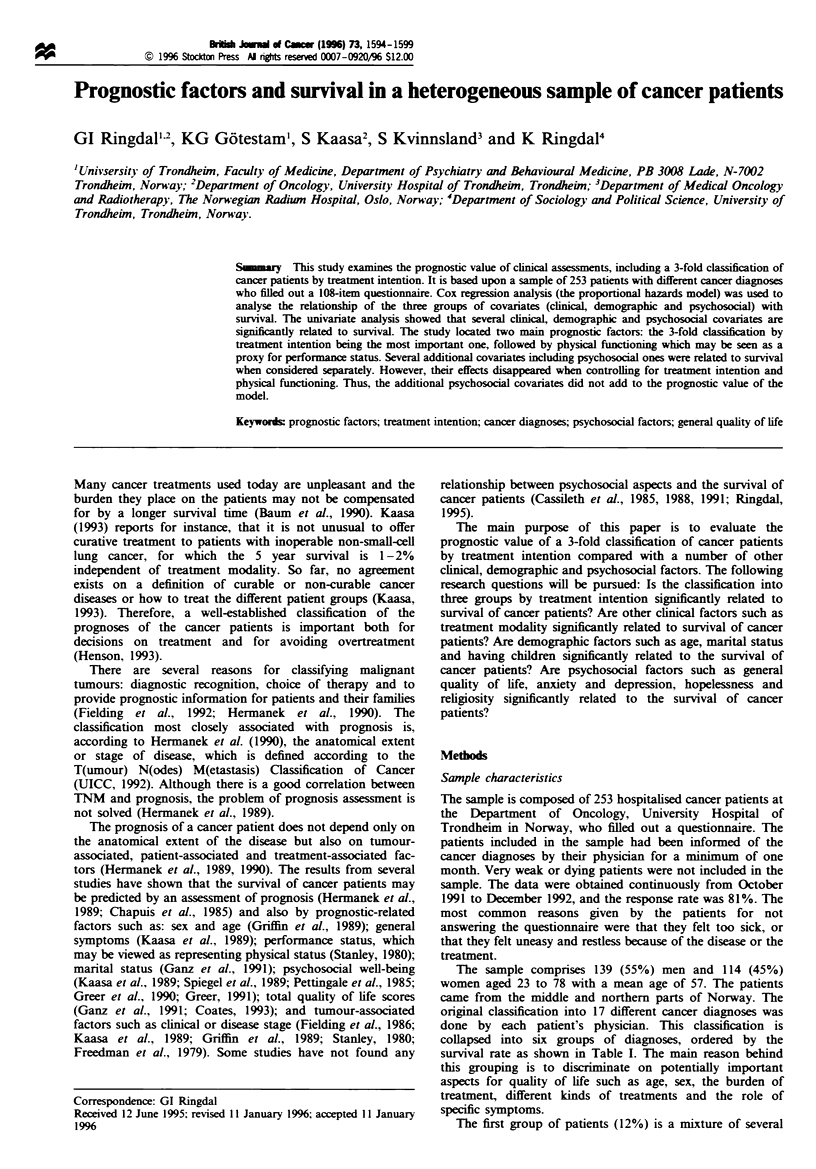
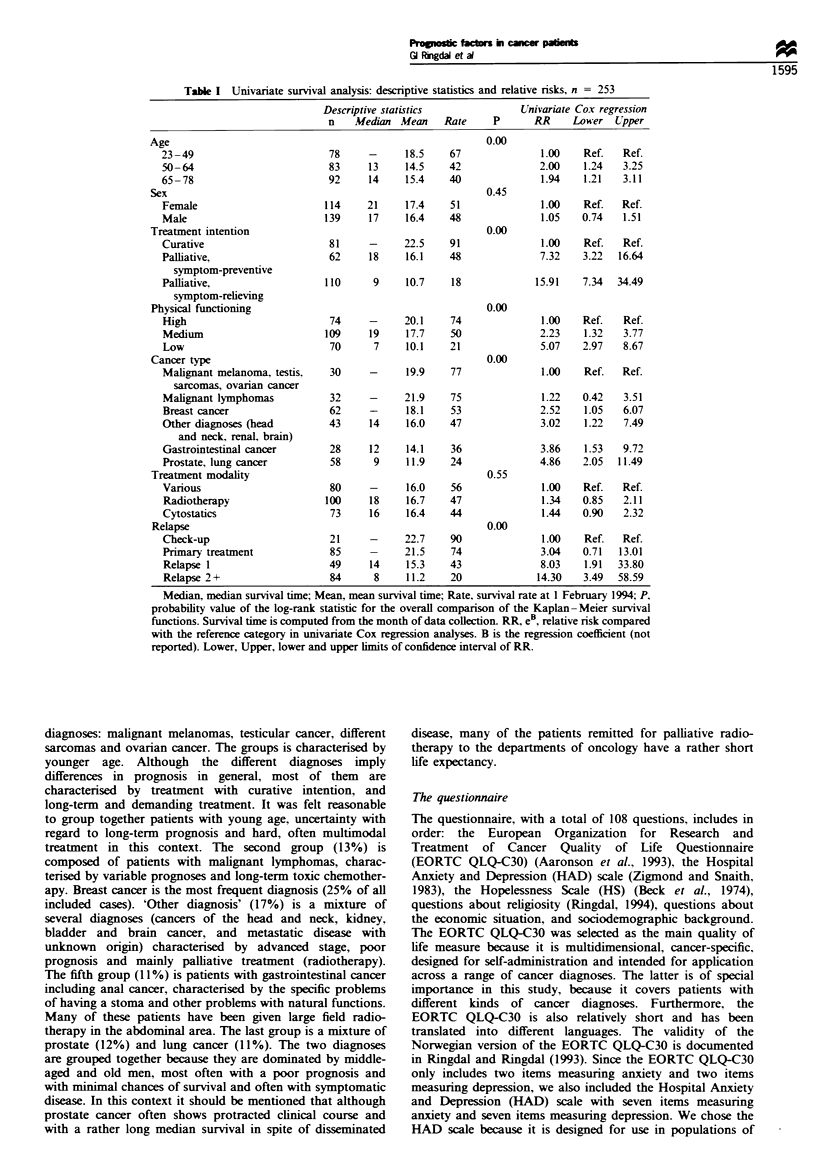
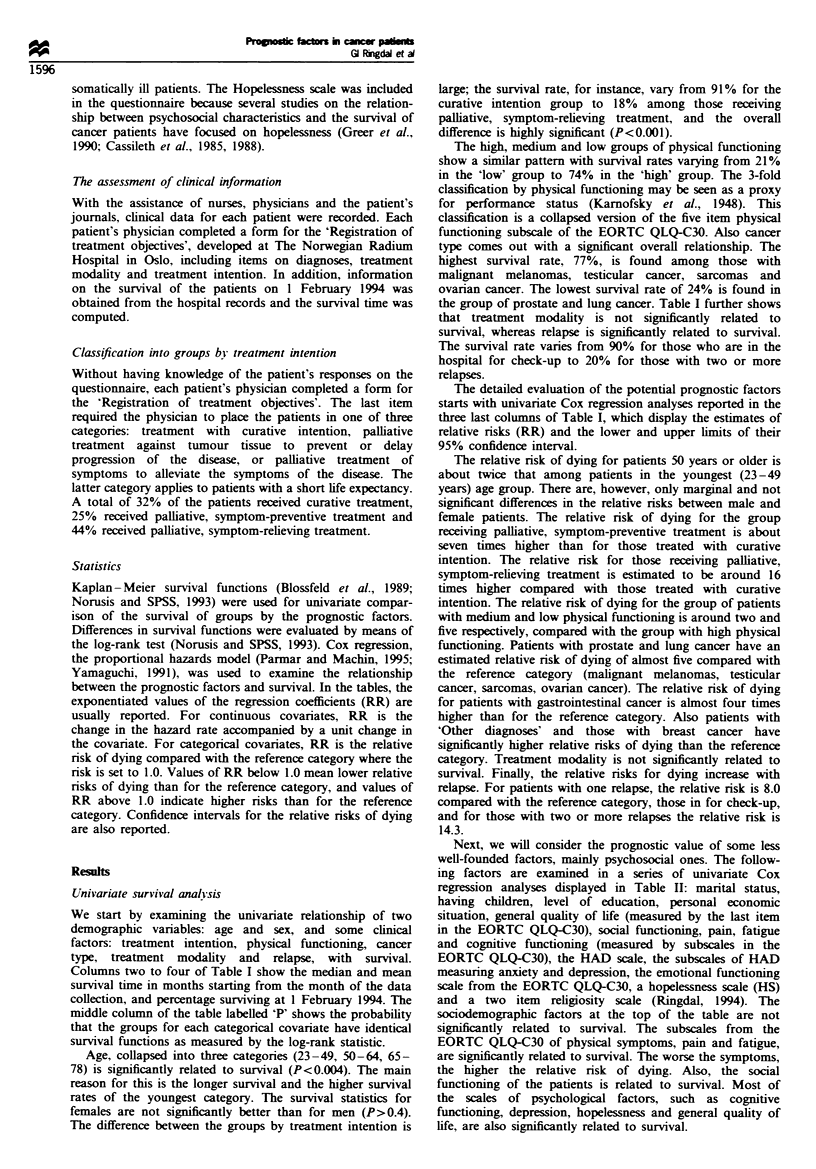
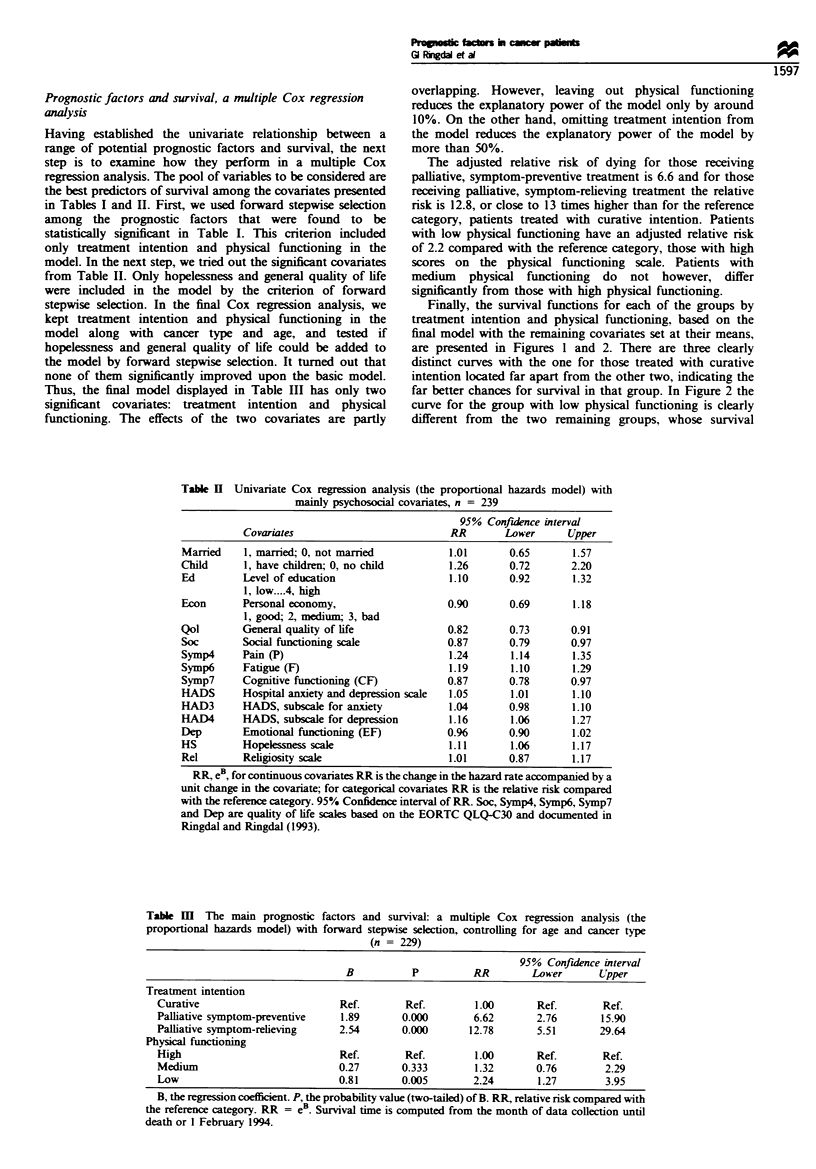
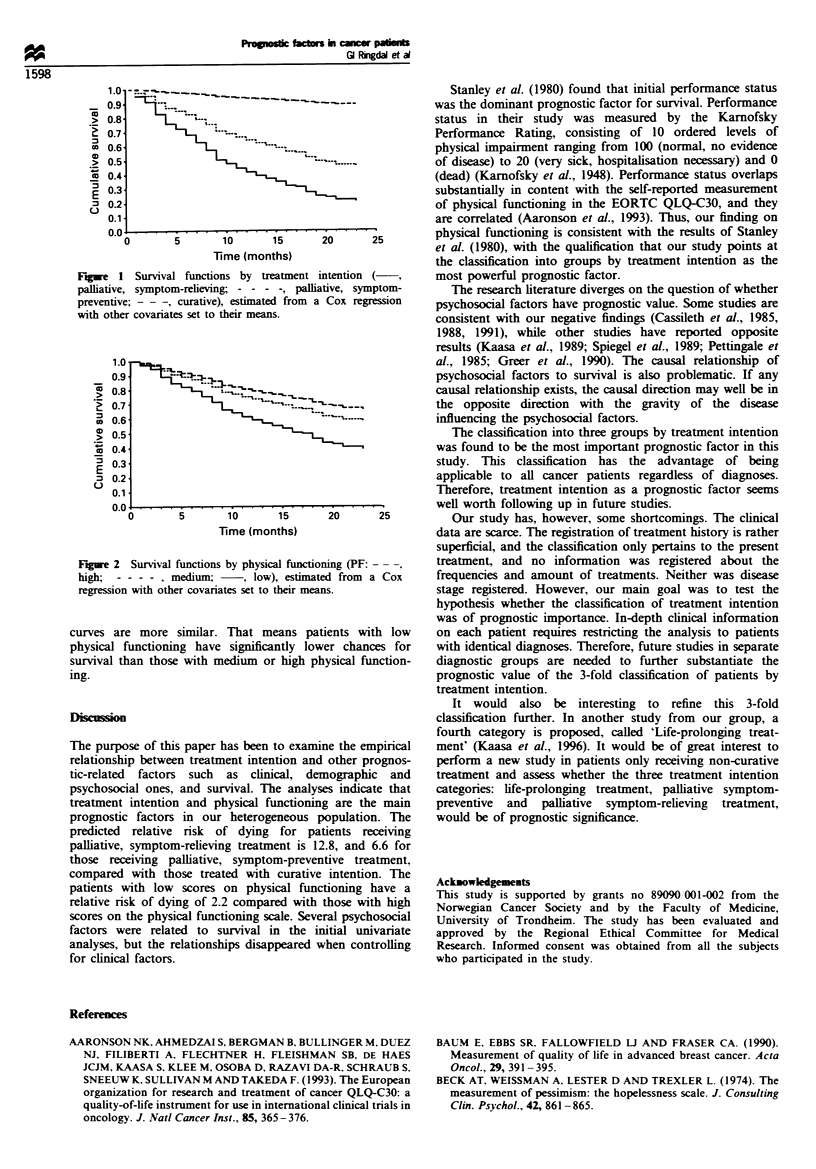

Selected References
These references are in PubMed. This may not be the complete list of references from this article.
- Aaronson N. K., Ahmedzai S., Bergman B., Bullinger M., Cull A., Duez N. J., Filiberti A., Flechtner H., Fleishman S. B., de Haes J. C. The European Organization for Research and Treatment of Cancer QLQ-C30: a quality-of-life instrument for use in international clinical trials in oncology. J Natl Cancer Inst. 1993 Mar 3;85(5):365–376. doi: 10.1093/jnci/85.5.365. [DOI] [PubMed] [Google Scholar]
- Baum M., Ebbs S. R., Fallowfield L. J., Fraser S. C. Measurement of quality of life in advanced breast cancer. Acta Oncol. 1990;29(3):391–395. doi: 10.3109/02841869009090020. [DOI] [PubMed] [Google Scholar]
- Beck A. T., Weissman A., Lester D., Trexler L. The measurement of pessimism: the hopelessness scale. J Consult Clin Psychol. 1974 Dec;42(6):861–865. doi: 10.1037/h0037562. [DOI] [PubMed] [Google Scholar]
- Cassileth B. R., Lusk E. J., Guerry D., Blake A. D., Walsh W. P., Kascius L., Schultz D. J. Survival and quality of life among patients receiving unproven as compared with conventional cancer therapy. N Engl J Med. 1991 Apr 25;324(17):1180–1185. doi: 10.1056/NEJM199104253241706. [DOI] [PubMed] [Google Scholar]
- Cassileth B. R., Lusk E. J., Miller D. S., Brown L. L., Miller C. Psychosocial correlates of survival in advanced malignant disease? N Engl J Med. 1985 Jun 13;312(24):1551–1555. doi: 10.1056/NEJM198506133122406. [DOI] [PubMed] [Google Scholar]
- Cassileth B. R., Walsh W. P., Lusk E. J. Psychosocial correlates of cancer survival: a subsequent report 3 to 8 years after cancer diagnosis. J Clin Oncol. 1988 Nov;6(11):1753–1759. doi: 10.1200/JCO.1988.6.11.1753. [DOI] [PubMed] [Google Scholar]
- Chapuis P. H., Fisher R., Dent O. F., Newland R. C., Pheils M. T. The relationship between different staging methods and survival in colorectal carcinoma. Dis Colon Rectum. 1985 Mar;28(3):158–161. doi: 10.1007/BF02554232. [DOI] [PubMed] [Google Scholar]
- Coates A. Prognostic implications of quality of life. Cancer Treat Rev. 1993;19 (Suppl A):53–57. doi: 10.1016/0305-7372(93)90057-x. [DOI] [PubMed] [Google Scholar]
- Fielding L. P., Fenoglio-Preiser C. M., Freedman L. S. The future of prognostic factors in outcome prediction for patients with cancer. Cancer. 1992 Nov 1;70(9):2367–2377. doi: 10.1002/1097-0142(19921101)70:9<2367::aid-cncr2820700927>3.0.co;2-b. [DOI] [PubMed] [Google Scholar]
- Fielding L. P., Phillips R. K., Fry J. S., Hittinger R. Prediction of outcome after curative resection for large bowel cancer. Lancet. 1986 Oct 18;2(8512):904–907. doi: 10.1016/s0140-6736(86)90422-8. [DOI] [PubMed] [Google Scholar]
- Freedman L. S., Edwards D. N., McConnell E. M., Downham D. Y. Histological grade and other prognostic factors in relation to survival of patients with breast cancer. Br J Cancer. 1979 Jul;40(1):44–55. doi: 10.1038/bjc.1979.139. [DOI] [PMC free article] [PubMed] [Google Scholar]
- Ganz P. A., Lee J. J., Siau J. Quality of life assessment. An independent prognostic variable for survival in lung cancer. Cancer. 1991 Jun 15;67(12):3131–3135. doi: 10.1002/1097-0142(19910615)67:12<3131::aid-cncr2820671232>3.0.co;2-4. [DOI] [PubMed] [Google Scholar]
- Greer S., Morris T., Pettingale K. W., Haybittle J. L. Psychological response to breast cancer and 15-year outcome. Lancet. 1990 Jan 6;335(8680):49–50. doi: 10.1016/0140-6736(90)90173-3. [DOI] [PubMed] [Google Scholar]
- Greer S. Psychological response to cancer and survival. Psychol Med. 1991 Feb;21(1):43–49. doi: 10.1017/s003329170001463x. [DOI] [PubMed] [Google Scholar]
- Griffin M. R., Bergstralh E. J., Coffey R. J., Beart R. W., Jr, Melton L. J., 3rd Predictors of survival after curative resection of carcinoma of the colon and rectum. Cancer. 1987 Nov 1;60(9):2318–2324. doi: 10.1002/1097-0142(19871101)60:9<2318::aid-cncr2820600934>3.0.co;2-b. [DOI] [PubMed] [Google Scholar]
- Henson D. E. Future directions for the American Joint Committee on Cancer. Cancer. 1992 Mar 15;69(6 Suppl):1639–1644. doi: 10.1002/1097-0142(19920315)69:6+<1639::aid-cncr2820691320>3.0.co;2-n. [DOI] [PubMed] [Google Scholar]
- Hermanek P., Guggenmoos-Holzmann I., Gall F. P. Prognostic factors in rectal carcinoma. A contribution to the further development of tumor classification. Dis Colon Rectum. 1989 Jul;32(7):593–599. doi: 10.1007/BF02554180. [DOI] [PubMed] [Google Scholar]
- Hermanek P., Hutter R. V., Sobin L. H. Prognostic grouping: the next step in tumor classification. J Cancer Res Clin Oncol. 1990;116(5):513–516. doi: 10.1007/BF01613004. [DOI] [PubMed] [Google Scholar]
- Kaasa S., Mastekaasa A., Lund E. Prognostic factors for patients with inoperable non-small cell lung cancer, limited disease. The importance of patients' subjective experience of disease and psychosocial well-being. Radiother Oncol. 1989 Jul;15(3):235–242. doi: 10.1016/0167-8140(89)90091-1. [DOI] [PubMed] [Google Scholar]
- Pettingale K. W., Morris T., Greer S., Haybittle J. L. Mental attitudes to cancer: an additional prognostic factor. Lancet. 1985 Mar 30;1(8431):750–750. doi: 10.1016/s0140-6736(85)91283-8. [DOI] [PubMed] [Google Scholar]
- Ringdal G. I., Ringdal K. Testing the EORTC Quality of Life Questionnaire on cancer patients with heterogeneous diagnoses. Qual Life Res. 1993 Apr;2(2):129–140. doi: 10.1007/BF00435732. [DOI] [PubMed] [Google Scholar]
- Spiegel D., Bloom J. R., Kraemer H. C., Gottheil E. Effect of psychosocial treatment on survival of patients with metastatic breast cancer. Lancet. 1989 Oct 14;2(8668):888–891. doi: 10.1016/s0140-6736(89)91551-1. [DOI] [PubMed] [Google Scholar]
- Stanley K. E. Prognostic factors for survival in patients with inoperable lung cancer. J Natl Cancer Inst. 1980 Jul;65(1):25–32. [PubMed] [Google Scholar]
- Zigmond A. S., Snaith R. P. The hospital anxiety and depression scale. Acta Psychiatr Scand. 1983 Jun;67(6):361–370. doi: 10.1111/j.1600-0447.1983.tb09716.x. [DOI] [PubMed] [Google Scholar]


